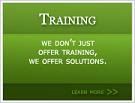Most people involved in organizational change experience a kaleidoscope of emotions. Regardless of the reason behind the change, feelings of anger, resentment, anxiety, resistance, sadness and excitement are common at different points in the change process. Feelings of fear often run rampant.
What makes organizational change so scary for so many people? What are they afraid of? Some may worry about being seen as incompetent to carry out new tasks, or worse yet, actually being unable to handle it. These anxieties all stem from a nearly universal fear of the unknown and, for many, turn the change process into a seemingly endless and frightening roller coaster ride.
Many companies fail to successfully implement change because they ignored some of the critical requirements in managing it.
When effecting changes in the organization, managers are dealing with people with mindsets and comfort zones that were built overtime. People tend to resist change because they do not want to step out of these comfort zones--they like to stay in an environment they are comfortable with. There are a number of things that need to be taken in to mind to help people accept and overcome the pain of change. This course aims to equip change managers with the knowledge skills and right mindset in managing change. They will also learn to identify the need for change, and strategize their way to successful change implementation. It all starts with checking their understanding of their own attitude towards change, recognize which attitudes need adjustment and then learn how to manage the change the organization undertakes. The workshop also uses the lessons found in the book “Who Moved My Cheese” by Dr. Spencer Johnson to emphasize on the typical behaviors people exhibit as they face change and what they should do to welcome and experience the benefits of change.
Target participants:
Methodologies
In order to ensure maximum participation and effectiveness, the following methodologies shall be employed:
· Story-telling
· Experiential learning activities
· Lecturettes
· Brainstorming
OBJECTIVES
After the session, the participants are expected to;
· Describe the nature and concept of the change process and its components.
· Explain the importance of anticipating and managing change
· Identify effective means in anticipating and managing change in the workplace.
· Apply the different approaches in overcoming conflicts and other forms of resistance to change.
· Achieve focus and control in managing change from start up to follow through.
· Create plans to apply learning to work.
Course Outline:
Introduction
- Opening Remarks
- House Rules
- Leveling of Expectations
- Ice Breaker
UNDERSTANDING CHANGE
- Telling of “Who Moved My Cheese” A Change fable.
- Applying Key “Cheese” Principles
- Understanding the dynamics of change
- Examining personal and organizational impact of change
- Examining the colliding force that affect the status quo and change.
ANTICIPATING AND PLANNING CHANGE
- Classifying types of change
- Identifying roles in the change process
- Focusing on the qualities of a change agent
- Accepting responsibility to lead change
- Communicating change
MANAGING RESISTANCE TO CHANGE
- Teamwork and Change
- Assessing reactions to change
- Uncovering manifestations of resistance
- Identifying causes of resistance
- Dealing with negative reactions
- Reviewing ineffective responses to resistance
- Focusing on means to overcome resistance
MANAGING CHANGE
- Choosing the success factors for effective change
- Identifying reasons why change efforts fail
- Guiding your staff to influence change behavior
- Leading the change process
- Keeping focus during transition
- Monitoring effectiveness of the change process
Forward Agenda
Closing activity








0 comments:
Post a Comment